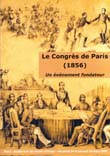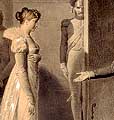| |
| |
THIS MONTH'S PAINTING
The arrival of Marie-Louise in Compiègne, by Jean-Baptiste ISABEY (1767-1855)
In his amassing of titles over the years, Isabey became successively: painter and draughtsman for His Majesty's cabinet; painter and draughtsman for ceremonies and foreign relations; organiser of public festivals and fêtes at the Tuileries; draughtsman of the Seal and of Titles; first painter of the empress Josephine's chamber; decorator for the imperial theatres; and drawing teacher to the empress Marie-Louise, in which role he succeeded Prud'hon. This latter job brought him welcome security and his pleasant nature made him soon very popular with Napoleon's new wife; as a close acquaintance of Josephine's, he had been concerned about his position after the divorce.
© Fondation Napoléon - Patrice Maurin-Berthier

|
|
|
| |
 |
 |
INTERNATIONAL CONFERENCE
The Paris Congress (1856), a founding moment
For the 150th anniversary of the Paris Congress of 1856 a conference has been organised on 24 and 25 March by the Friends of Napoleon III (Les Amis de Napoléon III) and the French Foreign Ministry, to be held in the auditorium of the Musée d'Orsay.
The Paris Congress of 1856, in which representatives of France, Great Britain, the Ottoman Empire (Turkey), Sardinia, Russia, Austria, and Prussia took part, brought peace after the Crimean War. and indeed it was the climax of Napoleon III's career. In the words of J. M. Thompson (Louis Napoleon and the Second Empire: 1955, p. 166), "[Louis Napoleon] succeeded, where Napoleon himself had failed, in winning the alliance of England and reversing the verdict of 1812. By re-establishing an Imperial dynasty and inspiring an international treaty, he had made himself the supplanter of Nicholas and France once more the predominant power on the continent - a power which might challenge the settlement of 1815".
For the full programme, click here.

|
|
|
| |
200 YEARS AGO
With the preparatory work for the Austerlitz (Vendôme) column completed under the instructions of Dominique-Vivant Denon, director of Beaux Arts or Fine Arts, Interior minister Champagny wrote a letter to the emperor on 12 March, 1806, requesting a favourable reply to the French nation's desire (which Denon had in fact surmised from a suggestion from the Institut) that the statue of Charlemagne, planned for the summit, should be replaced by one of the emperor. The commission for the statue of Napoleon in Roman costume was offered to Chaudet. After suggestion by Vivant Denon and the Institut, Napoleon decreed on 14 March, 1806, that «50,000 pounds of bronze taken from the cannon taken from the Russians and Austrians should be used for the construction of the Austerlitz Column. The bronze should be taken from the cannon least suitable for use.» (Correspondence, n° 9971) Begun on 25 August, 1806, the construction work on the column was completed (naturally) on 15 August, 1810.
For further details on the Vendôme column click here.
For details (in French) of the history of the creation of this monument, see the correspondance of Vivant Denon, on our fulltext website Napoleonica, [AN48] Paris, 19 February, 1806 and [AN52] Paris, 10 March, 1806, (including a detailed costing of the monument).
On 14 March, 1806, Napoleon announced to Talleyrand that he had decided to set his brother Louis on the Dutch throne: "The current constitution will be respected except that instead of the Grand Pensionary there will be a king". (Correspondence, n° 9970)
After the French victory at the battle of Fleurus (1794), the Low Countries became the Batavian Republic, founded by the French in 1795 with the support of French troops and given a French style constitution. In 1805, the Republic was further reformed making it closer to the centralised Consulate model, with political power centred on the person of the Grand Pensionary. In substituting his brother for the Grand Pensionary Napoleon continued his controversial policy of installing his siblings and family on the thrones of satellite or annexed countries.
150 YEARS AGO
On 16 March, 1856, at 3-15am, the Empress Eugénie gave birth to Napoléon Eugène Louis, the Prince impérial, after a long and difficult labour. This birth was the occasion for many demonstrations of joy throughout France and also led to certain charitable enterprises. A Fondation Eugène Napoléon for the education of young pauper girls was created in Paris. Many of those under the death penalty had their sentences commuted. And Napoleon III decided that he and his wife, the Empress Eugénie, would become the god-parents "of all the legitimate children born in France on 16 March, 1856" (Moniteur Universel, 16 March, 1856).
But also:
On 12 March, 1856, Charles Baudelaire (1821-1867) published Histoires extraordinaires, his translation of a collection of novels written by Edgar Allan Poe (1809-1849), the American poet and novelist. Indeed, Baudelaire had discovered and translated the works of Poe in 1854. Both men had not only the same vision of art but were also fascinated by evil, which Poe called "the demon of perversity".
Visit the website of the Edgar Allen Poe Museum in Richmond, Virginia, USA
Wishing you an excellent, Napoleonic, week.
Peter Hicks
Historian and Web editor
THE NAPOLEON.ORG BULLETIN, No 360, 10 - 16 March, 2006
Interested in the work of the Fondation Napoléon? Why not participate, either generally or in a specific project, by making a donation.
© this Napoleon.org weekly bulletin is published by the Fondation Napoléon. Reproduction or all or part of this bulletin is forbidden, without prior agreement of the Fondation Napoléon.

|
|
|
|
|
|
|
|
|
|
|
|
|
|
THIS WEEK in the MAGAZINE
SNIPPETS
- A Chinese Napoleonic Society
WEB SITES
- Napoléonic age philatelists (NAP), a web site of Napoleonic stamps
Go to the Napoleonic Directory, select 'Other' in the web sites site scroll bar menu, and slick on 'Search'.
WHAT'S ON
Study days:
- Trafalgar, how do we remember it?
Conferences:
- Two Frenchmen in Naples (Due Francesi a Napoli), Naples, Italy
Fairs:
- The 13th International Napoleonic Fair, St Albans, UK
Exhibitions:
- Treasures of the Fondation, Mexico 2006, Monterrey, Mexico
- "Beauty celebrating power": Vincenzo Monti in the Napoleonic period, Milan, Italy
- Napoléon an intimate portrait, Tallahassee, Florida, USA
- "Battle in a sittingroom." The Austerlitz wallpaper, Museo Napoleonico, Rome, Italy
- In the Service of Napoleon. The Dutch in time of War 1792-1815, Delft, Netherlands
Entertainments:
Thursdays at the Museum of Florida History, Tallahassee, Florida, USA
Got a problem with the letter? Try the home page: http://www.napoleon.org
<<
|
|


